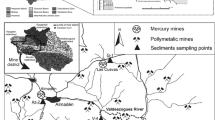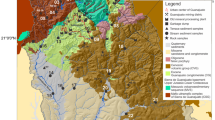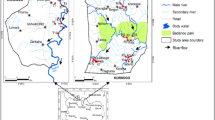Abstract
The environmental implications of mining activities are of worldwide concern. An environmental evaluation at the basin level was conducted because of widespread mining in Cajamarca in Northern Peru. A sediment monitoring program was developed at the Jequetepeque basin, located in Cajamarca. A total of 16 sites were monitored at three different times between June 2009 and July 2010, and a total of 42 samples were collected. All samples were analyzed by microwave digestion and by a sequential extraction scheme following the three-stage European Community Bureau of Reference (three-stage BCR) protocol. Trace element mobilization from the sediments to the water column was assessed by the risk assessment code (RAC). Spatial and temporal distribution of trace elements was evaluated by principal component analysis and hierarchical cluster analysis. Cd, Zn, As, and Pb showed the highest concentrations independent of season. Notably, Cu concentration and mobility increased during the wet season for all samples. Additionally, Hg concentration and mobility increased during the wet season near the mine sites. According to the enrichment factor, the highest enrichments of Cd, Zn, Pb, and As were related to mine runoff. The effect of trace elements near the mine sites at the Jequetepeque basin was considered a significant threat to the environment due to Cd, Zn, Pb, and As, and the concentrations of Cu and Hg were also considered a concern. This work establishes a baseline for the environmental quality status of the Jequetepeque basin that may support water quality management in Peru.





Similar content being viewed by others
References
Andrade E, Alves JC, Dos Santos I, Alves JH, Garcia C, Spinola A (2010) Assessment of trace metals contamination in estuarine sediments using a sequential extraction technique and principal component analysis. Microchem J 96:50–57
Arain MB, Kazi TG, Jamali MK, Afridi HI, Jalbani N, Sarfraz RA et al (2008) Time saving modified BCR sequential extraction procedure for the fraction of Cd, Cr, Cu, Ni, Pb and Zn in sediment samples of polluted lake. J Hazard Mater 160:235–239
Barrios JE (2006) Water quality management: missing concept for developing countries. In: Biswas AK, Tortajada C, Braga B, Rodriguez D (eds) Water quality management in the Americas. Springer, Netherlands, pp 137–146
Bengraine K, Marhaba TF (2003) Using principal component analysis to monitor spatial and temporal changes in water quality. J Hazard Mater 100:179–195
Borja A (2005) The European Water Framework Directive: a challenge for nearshore, coastal and continental shelf research. Cont Shelf Res 25:1768–1783
Borja A, Valencia V, Franco J, Muxika I, Bald J, Belzunce MJ et al (2004) The water framework directive: water alone, or associated with sediment and biota, in determining quality standards? Mar Pollut Bull 49:8–11
Burton GA (2002) Sediment quality criteria in use around the world. Jpn Soc Limnol 3:65–75
Butler BA (2011) Effect of imposed anaerobic conditions on metals release from acid-mine drainage contaminated streambed sediments. Water Res 45:328–336
Cáceres-Choque LF, Ramos-Ramos OE, Valdez-Castro SN, Choque-Aspiazu RR, Choque-Mamani RG, Fernández-Alcazar SG, Sracek O, Bhattacharya P (2013) Fractionation of heavy metals and assessment of contamination of the sediments of Lake Titicaca. Environ Monit Assess 185:9979–9994. doi:10.1007/s10661-013-3306-0
Canadian Council of Ministers of the Environment (CCME). Canadian sediment quality guidelines for the protection of aquatic life. Summary tables. Canada; 2002
Cánovas CR, Hubbard CG, Olias M, Nieto JM, Black S, Coleman ML (2008) Hydrochemical variations and contaminant load in the Rio Tinto (Spain) during flood events. J Hydrol 350:25–40
Canuto FAB, Garcia CAB, Alves JPH, Passos EA (2013) Mobility and ecological risk assessment of trace metals in polluted estuarine sediments using a sequential extraction scheme. Environ Monit Assess 185:6173–6185. doi:10.1007/s10661-012-3015-0
Chen CM, Liu MC (2006) Ecological risk assessment on a cadmium contaminated soil landfill—a preliminary evaluation based on toxicity tests on local species and site-specific information. Sci Total Environ 359:120–129
Chen CK, Chen CF, Cheng DD, Chiu W (2008) Distribution and accumulation of heavy metals in the sediments of Kaohsiung Harbor. Taiwan Microchem J 90:159–163
Coynel A, Blanc G, Marache A, Schafer J, Dabrin A, Maneux E et al (2009) Assessment of metal contamination in a small mining- and smelting-affected watershed: high resolution monitoring coupled with spatial analysis by GIS. J Environ Monit 11:962–976. doi:10.1039/b818671e
Deely JM, Fergusson JE (1994) Heavy metal and organic matter concentrations and distributions in dated sediments of a small estuary adjacent to a small urban area. Sci Total Environ 153:97–11
European Commission, EC (2000) Directive 2000/60/EC, establishing a framework for community action in the field of water policy. European Commission PE-CONS 3639/1/100 REV 1, Luxembourg
Förstner U, Müller G (1973) Heavy metal accumulation in river sediments: a response to environmental pollution. Geoforum 4:53–61
Förtsner, Salomons (2010) Sediment research, management and policy. A decade of JSS. J Soil Sediment 10:1440–1452
Galán E, Gómez-Ariza JL, González I, Fernández-Caliani JC, Morales E et al (2003) Heavy metal partitioning in river sediments severely polluted by acid mine drainage in the Iberian Pyrite Belt. Appl Geochem 18:409–421
Ghrefat H, Yusuf N (2006) Assessing Mn, Fe, Cu, Zn, and Cd pollution in bottom sediments of Wadi Al-Arab Dam, Jordan. Chemosphere 65:2114–2121
Gismera MJ, Lacal J, da Silva P, García R, Sevilla MT, Procopio JR (2004) Study of metal fractionation in river sediments. A comparison between kinetic and sequential extraction procedures. Environ Pollut 127:175–182
Goldhaber MB, Morrison JM, Holloway JM, Wanty RB, Helsel DR, Smith DB (2009) A regional soil and sediment geochemical study in northern California. Appl Geochem 24:1482–1499
Guevara-Riba A, Sahuquillo A, Rubio R, Rauret G (2004) Assessment of metal mobility in dredged harbour sediments from Barcelona. Spain Sci Total Environ 321:241–255
Hering D, Borja A, Carstensen J, Carvalho L, Elliot M, Feld CK et al (2010) The European Water Framework Directive at the age of 10: a critical review of the achievements with recommendations for the future. Sci Total Environ 408:4007–4019
Higueras P, Oyarzun R, Jorge Oyarzun J, Maturana H, Lillo J, Morata D (2004) Environmental assessment of copper–gold–mercury mining in the Andacollo and Punitaqui districts, northern Chile. Appl Geochem 19:1855–1864
Idris AM (2008) Combining multivariate analysis and geochemical approaches for assessing heavy metal level in sediments from Sudanese harbors along the Red Sea coast. Microchem J 90:159–163
Jain CK (2004) Metal fractionation study on bed sediments of River Yamuna, India. Water Res 38:569–578
Kartal S, Aydın Z, Tokaliouglu S (2006) Fractionation of metals in street sediment samples by using the BCR sequential extraction procedure and multivariate statistical elucidation of the data. J Hazard Mater 136:80–89
Luo X, Yu S, Zhu Y, Li X (2012) Trace metal contamination in urban soils of China. Sci Total Environ 421–422:17–30
Malferrari D, Brigatti MF, Laurora A, Pini S (2009) Heavy metals in sediments from canals for water supplying and drainage: mobilization and control strategies. J Hazard Mater 161:723–729
Margí E, Salvadó V, Queralt I, Hidalgo M (2004) Comparison of three-stage sequential extraction and toxicity characteristic leaching tests to evaluate metal mobility in mining wastes. Anal Chim Acta 524:151–159
Martínez Lladó X (2008) Presència, mobilitat i riscd’elementstraça en sòlsnaturals. Universitat Politècnica de Catalunya, Programa de doctorat de recursos naturals i mediambient
Medici L, Bellanova J, Belviso C, Cavalcante F, Lettino A, Paquale P et al (2011) Trace metals speciation in sediments of the Basento River (Italy). Appl Clay Sci 53:414–442
Mester Z, Cremisini C, Ghiara C, Morabito R (1998) Comparison of two sequential extraction procedures for metal fractionation in sediment samples. Anal Chim Acta 359:133–142
Nannoni F, Protano G, Riccobono F (2011) Fractionation and geochemical mobility of heavy elements in soils of a mining area in northern Kosovo. Geoderma 161:63–73
Oyeyiola AD, Olayinka OK, Alo BI (2011) Comparison of three sequential extraction protocols for the fractionation of potentially toxic metals in coastal sediments. Environ Monit Assess 172:319–327. doi:10.1007/s10661-010-1336-4
Passos ED, Alves JC, dos Santos IS, Alves JDH, Garcia CAB, Costa ACS (2010) Assessment of trace metals contamination in estuarine sediments using a sequential extraction technique and principal component analysis. Microchem J 96:50–57
Pérez G, Valiente M (2005) Determination of pollution trends in an abandoned mining site by application of a multivariate statistical analysis to heavy metals fractionation using SM&T-SES. J Environ Monit 7:29–36
Pérez-López R, Álvarez-Valero AM, Nieto JM, Sáez R, Matos JM (2008) Use of sequential extraction procedure for assessing the environmental impact at regional scale of the São Domingos Mine (Iberian Pyrite Belt). Appl Geochem 23:3452–3463
Prudencio MI, Gonzalez MI, Dias MI, Galán E, Ruiz F (2007) Geochemistry of sediments from El Melah lagoon (NE Tunisia): a contribution for the evaluation of anthropogenic inputs. J Arid Environ 69:285–298
Reimann C, de Caritat P (2005) Distinguishing between natural and anthropogenic sources for elements in the environment: regional geochemical surveys vs enrichment factors. Sci Total Environ 337:91–107
Reimann C, Filzmoser P, Garrett RG (2005) Background and threshold: critical comparison of methods of determination. Sci Total Environ 346:1–16
Routh J, Hjelmquist P (2011) Distribution of arsenic and its mobility in shallow aquifer sediments from Ambikanagar, West Bengal, India. Joyanto Rout, Per Hjelmquist. Appl Geochem 26:505–515
Sahuquillo A, López-Sánchez JF, Rubio R, Rauret G, Thomas RP, Davidson CM et al (1999) Use of a certified reference material for extractable trace metals to assess sources of uncertainty in the BCR three-stage sequential extraction procedure. Anal Chim Acta 382:317–327
Salvarredy-Aranguren MM, Probst A, Roulet M, Isaure MP (2008) Contamination of surface waters by mining wastes in the Milluni Valley (Cordillera Real, Bolivia): mineralogical and hydrological influences. Appl Geochem 23:1299–1324
Sigel K, Klauer B, Pahl-Wostl C (2010) Conceptualising uncertainty in environmental decision-making: the example of the EU Water Framework Directive. Ecol Econ 69:502–510
Sutherland RA (2000) Bed sediment-associated trace metals in an urban stream, Oahu, Hawaii. Environmental Geology 39 (6) April 2000
Ure AM, Quevauviller PH, Muntau H, Griepink B (1993) Speciation of heavy metals in soils and sediments. An account of the improvement and harmonization of extraction techniques undertaken under the auspices of the BCR of the Commission of the European Communities. Int J Environ Analitical Chem 51:135–151
Varejao EVV, Bellato CR, Fontes MPF (2009) Mercury fractionation in stream sediments from the Quadrilátero Ferrífero gold mining region, Minas Gerais State. Braz Environ Monit Assess 157:125–135
Villalobos-Castañeda B, Alfaro-Cuevas R, Cortés-Martínez R, Martínez-Miranda V, Márquez-Benavides L (2010) Distribution and partitioning of iron, zinc, and arsenic in surface sediments in the Grande River mouth to Cuitzeo Lake. Mexico Environ Monit Assess 166:331–346. doi:10.1007/s10661-009-1005-7
Yacoub C, Foguet A (2013) Slope effects on SWAT modeling in a mountainous basin. J Hydrol Eng 18(12):1663–1673
Yacoub C, Pérez-Foguet A, Miralles N (2012) Trace metal content of sediments close to mine sites in the Andean region. The Scientific World Journal; 12 pages. Doi:10.1100/2012/732519.
Yacoub C, Blázquez N, Pérez-Foguet A, Miralles N (2013) Spatial and temporal trace metal distribution of a Peruvian basin: recognizing trace metal sources and assessing the potential risk. Environ Monit Assess. doi:10.1007/s10661-013-3147-x
Acknowledgement
This research was financially supported by the Ministerio de Educación y Ciencia, Madrid, CTM 2008-06776C-02, and by the UPC’s Center for Development Cooperation. The authors gratefully acknowledge the Cajamarca Regional Government, NiltonDeza, Rebeca Araujo, and GRUFIDES for support in the monitoring process. The authors are also grateful to Miriam Planas Marin for her contribution to this study and the contribution of two anonymous reviewers for their comments and constructive criticism to improve the manuscript’s quality.
Author information
Authors and Affiliations
Corresponding author
Additional information
Responsible editor: Vera Slaveykova
Electronic supplementary material
Below is the link to the electronic supplementary material.
ESM 1
(DOCX 780 kb)
Rights and permissions
About this article
Cite this article
Yacoub, C., Pérez-Foguet, A., Valderrama, C. et al. Impacts on effluent contaminants from mine sites: risk assessment, fate, and distribution of pollution at basin scale. Environ Sci Pollut Res 21, 5960–5971 (2014). https://doi.org/10.1007/s11356-014-2559-7
Received:
Accepted:
Published:
Issue Date:
DOI: https://doi.org/10.1007/s11356-014-2559-7




